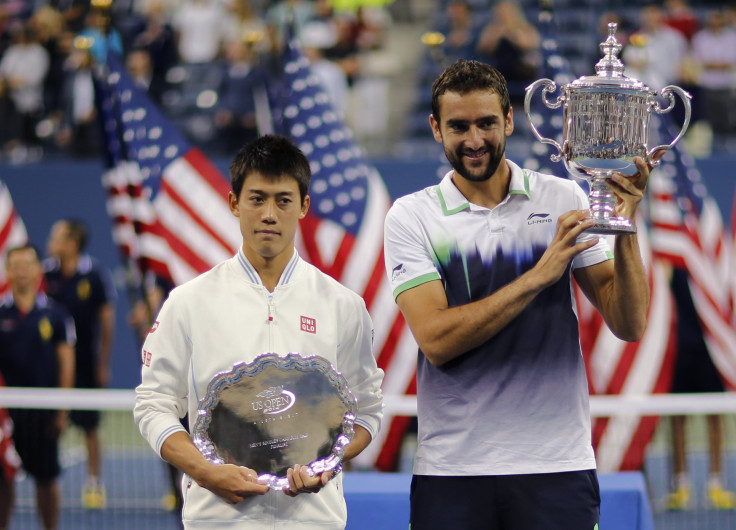US Open 2014 Men’s Final TV Ratings: Čilić And Nishikori Struggle To Draw Viewers As CBS Bows Out

The 2014 U.S. Open will be remembered for many things, particularly the media coverage. CBS bowed out after 47 years of covering the famed tennis major with one of the lowest rated finals in history. With a match lacking tennis’s big names and beginning at 5 p.m. EDT on a Monday, there was little surprise that Marin Čilić’s straight-sets victory drew just a 1.9 overnight rating, down 32 percent from Rafael Nadal’s win over Novak Djokovic last year, reports Sports Business Daily. It was also less than half the 4.0 rating drawn by the women’s final between Serena Williams and Caroline Wozniacki, played on Sunday.
Huge crowds are thought to have watched on in Čilić’s and Nishikori’s native countries of Croatia and Japan, respectively. But CBS, which will hand over coverage of the finals next year to ESPN, will have been anticipating the low U.S. audience for its finale when Nishikori and Čilić scored major upsets over two of the sport's greats, Djokovic and Roger Federer, respectively, in the semifinals. It produced not only the first Grand Slam final in almost a decade not to feature one of tennis’s famed Big Four -- Federer, Nadal, Djokovic and Andy Murray -- but the first since 2002 not to feature a top-nine seed. Both Čilić, seeded 14, and Nishikori, seeded 10, were playing in their first Grand Slam final.
As much as the lack of star power, the numbers were also clearly impacted by the final’s scheduling. This was the seventh consecutive men’s U.S. Open final to be played on a Monday, with last year’s 2.8 being the highest during that time. All others have fallen below 2.5, which was the lowest rating prior to 2008, when the final was contested on a Sunday.
The U.S. Open’s scheduling has long been the target of criticism. For years it was the only Grand Slam to have the men’s semifinals and final on back-to-back days, in order to be able to offer viewers a “Super Saturday,” featuring both men’s semifinals and the women’s final. But for five straight years, beginning in 2008 the tournament was extended by a day due to rain. After frequent complaints from players, last year it was announced that the final would actually be scheduled for the Monday, as it was again this year, in order to provide the men’s finalists an extra day’s rest. The USTA had to pay CBS $6 million in compensation for the switch, according to Sports Illustrated’s Jon Wertheim.
From 2015, the U.S. Open will adapt the same schedule as the three other Grand Slams, with the men’s semifinals on Friday, women’s final on Saturday and men’s final on Sunday. That should certainly help the ratings for ESPN, which paid $825 million for coverage over the next 11 years. ESPN already covered the bulk of the U.S. Open, with CBS bringing the Labor Day weekend action and the finals to broadcast audiences. ESPN will also be encouraged by the fact that by 2016 a roof is set to have been constructed over the USTA National Tennis Center’s showpiece court, Arthur Ashe Stadium. In doing so, the U.S. Open will join Wimbledon and the Australian Open in ensuring that there are none of the long rain breaks that broadcasters hate. It will also end the chance of ratings-killing Monday finals.
Still, challengers lie ahead for the cable broadcaster. While this year’s final had something of a freak nature to it and few, if anyone, predicted that Čilić would become the next man to break through and become a Grand Slam champion, it can still be seen as part of a growing trend toward the end of the Big Four era. Men’s tennis has arguably never had it so good in terms of sustained high quality at the top of the sport as it has in the past decade. With a small selection of players so dominant, rivalries build up and personalities can be sold to audiences.
But Stan Wawrinka’s win at the Australian Open this year has given the rest of the players the belief that Federer, Nadal, Djokovic and Murray, who had previously won every Grand Slam title between them since the 2009 U.S. Open, could be beaten. The shocking semifinal wins by Nishikori and Čilić at Flushing Meadows this year backed that up.
The Big Four will surely continue to win more Grand Slams, but their stranglehold may well be over. Federer is now aged 33, while Nadal, who missed the U.S. Open because of a wrist injury, continues to struggle to play a full schedule because of fitness concerns. Djokovic, meanwhile, has had an up and down year, and just got married, and his wife is expecting their first child. Murray, meanwhile, has been unable to rediscover his full fitness and confidence since back surgery following his Wimbledon win last year.
It many ways it is exciting times, but the period of transition will certainly be tough for those looking to sell the sport. What would help ESPN is the emergence of a top American male player. The now retired Andy Roddick was the last American man in a U.S. Open final, when he lost to Federer in 2006. That final drew a 5.1 rating, which no final, men’s or women’s, has matched since, according to Sports Media Watch. The last four women’s finals have significantly out-rated the men’s, in part because of scheduling, but also because each featured American star Serena Williams.
© Copyright IBTimes 2024. All rights reserved.





















